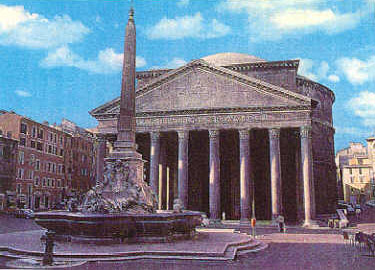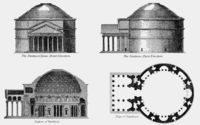Pantheon, Rome
 From Conservapedia
From Conservapedia 
The Pantheon is a temple in Rome dedicated to the seven planetary gods: Jupiter, Neptune, Pluto, Mars, Venus, Mercury, and Saturn.
Contents
- 1 History
- 2 The Architecture
- 3 See also
- 4 External links
History[edit]
It was first designed and erected by consul Agrippa between 27 and 25 BC. In 80 AD, it was destroyed in a fire, and was restored immediately by emperor Domitian. It burned down again in another fire in 110 AD, and this time it was restored and completely rebuilt by Hadrian, who made the building as it is known today, from 118 to 128 AD. In 609, Byzantine emperor Phocas donated the building to then-Pope Boniface IV, who made it into a Roman Catholic church, Santa Maria ad Martyres, or The Church of Saint Mary and all the Martyres. This action preserved the building throughout the ages. It is still in use as a Catholic Church and holds service on all major Catholic holidays. King Vittorio Emanuele III of Italy is buried in the church, along with several leading Italian statesmen, artists and scientists.
The Architecture[edit]

The building is composed of two parts: The porch, a standard Roman feature with front stairs going up to a platform surrounded by pillars with a door to the dome, and the dome, which was a huge circular room with a dome overhead. The dome room had a maximum height of 43.3 meters, and the diameter of the circle was exactly 43.3 meters. Because of this, a perfect sphere could fit into the room, with a diameter of 43.3 meters.
See also[edit]
- Ancient Rome
- Architecture
- Pantheon, Paris
External links[edit]
- Imperium in the Pantheon of Rome and its Pavimentum
- The Roman Pantheon: The Triumph of Concrete
Categories: [Architecture] [Ancient Rome] [Tourist Attractions]
↧ Download as ZWI file | Last modified: 02/27/2023 01:53:40 | 72 views
☰ Source: https://www.conservapedia.com/Pantheon,_Rome | License: CC BY-SA 3.0
 ZWI signed:
ZWI signed: KSF
KSF